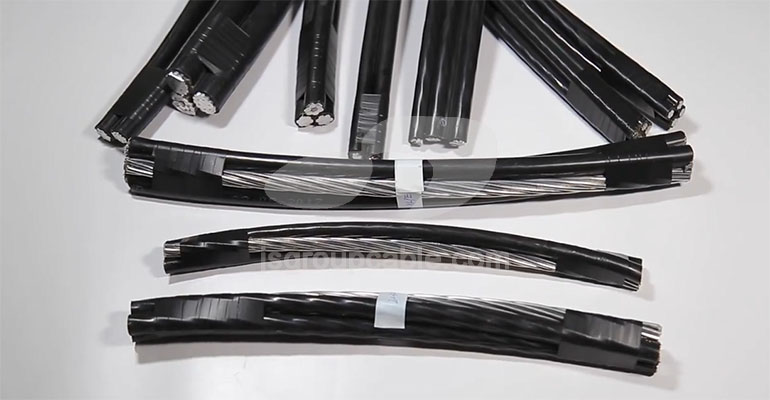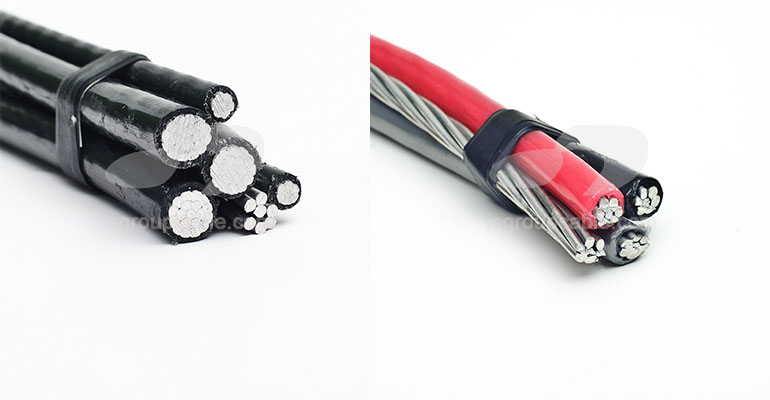- Offices Time:24 Hours Online
- Email:[email protected]
- WhatsApp:+8618339938759

Posted on December 15, 2022
What is overhead insulated conductor (ABC cable)?
Overhead insulated conductors is a very novel overhead power distribution system. It offers increased safety and reliability, lower power consumption and ultimately system economy by reducing installation, maintenance and operating costs. In the previous article, we introduced the advantages and disadvantages of overhead insulated conductors, so let’s take a closer look at its structure and performance today!
1.Structure of overhead insulated conductors (ABC cables)
line core. Overhead insulated conductors are divided into two types: aluminum core and copper core. In the distribution network, the aluminum core is widely used, mainly because the aluminum material is relatively light and cheap, and has low requirements for line connectors and support parts. In addition, the original distribution lines are mainly steel-cored aluminum stranded wires. The selection of aluminum core wire facilitates the connection with the original network. In actual use, aluminum core wires are often used. Copper core wire is mainly used as the down conductor of transformer and switchgear.
Insulation Materials. There are two types of insulation protective layer for overhead insulated conductors: thick insulation (3.4mm) and thin insulation (2.5mm). Operation with thick insulation allows frequent contact with trees, and operation with thin insulation allows only short-term contact with trees. The insulating protective layer is divided into cross-linked polyethylene and light polyethylene, and the insulation performance of cross-linked polyethylene is better.
2.Laying method of overhead insulated conductors (ABC cables)
Single conventional laying method. This erection method is to use the conventional cement poles with bare wires, iron accessories and ceramic insulator accessories, and erect them according to the erection method of bare wires, which is more suitable for the reconstruction of old lines and areas with sufficient corridors. Single laying usually uses special insulating brackets to suspend the wires. This method can increase the number of circuits erected, save line corridors, and reduce the unit cost of lines.

3.Main properties and advantages of overhead insulated conductors (ABC cables)
Good insulation performance. With an extra layer of insulation, the performance is superior to that of bare wires, which can reduce the detailed distance of lines, reduce the insulation requirements for line supports, and increase the number of circuits of lines erected on the same pole.
Good corrosion resistance. Because the outer layer has an insulating layer, it is less oxidized and corroded than bare wires, and has stronger corrosion resistance, which can prolong the service life of the wires.
Prevent external damage, reduce the influence of external factors such as trees, flying objects, metal films and dust, and reduce phase-to-phase lines and grounding accidents.
The strength meets the requirement. Although the insulated wire lacks the steel core, it is relatively tough, and the mechanical strength of the entire dropped wire also meets the requirements of the stress design.
Compared to bare overhead distribution lines, overhead insulated conductors (ABC cables) have very high reliability during service. Since the mains and neutral conductors are insulated with the best dielectric material, good protection against line and ground faults in high winds or falling trees or birds, especially in hilly areas and forests encountered in rural distribution networks, faults The rate is lower.
High insulation to ground in all polluted atmospheres with negligible current flow and low losses.
Multiple circuits of power cords and telephone cords can be connected on the same set of poles or any other support such as a wall etc.
Better adaptability, it can run simultaneously with the existing overhead bare conductor system without any interference.
High capacitance and low inductance result in low line impedance. Lower voltage drop, higher current carrying capacity, better voltage regulation. Longer spans and longer distance lines allow for better system stability.
Overhead insulated conductors (ABC cables) are safer than bare conductors.
Can be hung in dense vegetation and forests. Additional connections can be made quickly and easily with the hot wire connector. Overall line costs are reduced. Maintenance costs are reduced. It is harder to tap the ABC cables, which reduces theft, resulting in lower distribution losses.
4.Design and construction of overhead insulated conductors (ABC cables)
Wire arrangement and spacing. The wire arrangement of the overhead insulated line is basically the same as that of the bare wire line, and can be divided into: triangular, vertical, horizontal, and multi-circuit erection on the same pole. The span of overhead insulated lines should be controlled at 50m.
Phase-to-phase distance of insulated conductors. Since overhead insulated conductors have good insulation properties, the distance between phases is smaller than that of bare conductor lines, but the distance between phases in vertical and triangular arrangements is not less than 0.3m, and the distance between phases in horizontal arrangements is not less than 0.4m. Two-circuit lines erected on the same pole The vertical distance and horizontal distance shall not be less than 0.5m.
Connection of insulated wires. The connection of the insulated wires is not allowed to be twisted, and the insulated wires should not be connected within the span as far as possible, and can be connected when the tension rod is jumpered. If it is really necessary to connect within the span, within a span, each wire shall not exceed one joint, and the distance between the joint and the fixed point of the wire shall not be less than 0.5m.
Fixing of insulated wires. Insulated wires and insulators are fixed with insulated binding wires. For pin-type or rod-type insulators, the straight rods are bound in the top groove, and the direct angle rods are bound in the side grooves in the side grooves.
Post categories
Most Popular Posts
-
The 136th Canton Fair welcomes you to participate!
October 12, 2024 -
High temperature cable introduction
July 26, 2024 -
Kenya Power and Energy Exhibition 2024
June 11, 2024 -
Introduction of rubber sheathed cable
June 5, 2024





